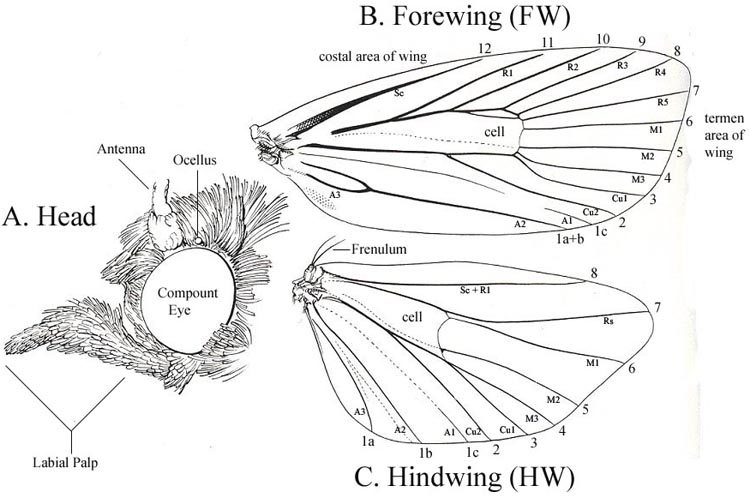The color patterns on moth wings are made up of tiny overlapping scales which can be seen very clearly under a microscope. For many species, these color patterns can be used for identification. However, color patterns are usually too variable within a genus to be useful in identification. The most reliable way to identify genera of Hawaiian tortricids is by wing venation. The branching patterns of the wing veins provide structural support and are unique for each genus, but are often obscured by the scales. Although the veins can often be seen by looking at the underside of the wings under a microscope, sometimes it is necessary to "clear" the wings in order to see the necessary features. One method of clearing is simply to use a fine brush to remove scales from the underside of the wing. This is often sufficient for identification purposes and leaves the upper surface and color patterns intact. A second method that is used for more detailed analysis and archival purposes is to clear, stain, and mount the wings. To do this the wings are removed from the body, wet with ethyl alcohol, cleared with bleach, rinsed with water, stained with acid fuchsin (or comparable dye), and mounted on a microscope slide with Euperal (or comparable mounting medium).
The wing vein features that are useful for identifying genera of Hawaiian Tortricidae (figure 2) include the number of veins; whether or not some of those veins are connected for a short distance or separated along their entire length; and whether or not special folds or pockets ("sex pouches") occur within the wing. Sex pouches along the wing (figures 1e & 1f) often contain specialized scales that disseminate pheromones used during mate finding and mate recognition. In Torticidae, these pockets occur in the males, and so are not useful characters when a female of the species needs to be identified. It is often possible to tell male from female moths without having to dissect the genitalia. In some cases, the genitalia protrude far enough from the hind end to distinguish males (figure 1a) from females (figure 1b). And in the family Tortricidae, the frenulum (which links the fore- and hindwings together) is composed of two or three bristles (females - figure 1d) or one composite bristle (males - figure 1c). Other sexually dimorphic characters are present in particular species (eg. sex pouches, antennal notches, tibial scales).
|
a) Male genitalia
|
b) Female genitalia
|
c) Male frenulum
|
d) Female frenulum
|
e) Forewing pouch
|
f) Hindwing pouch
|
| Figure 1. Sexually dimorphic features in Tortricidae. a) male genitalia (barely) protruding from Bactra straminea; b) female genitalia (barely) protruding from Eccoptocera sp.; c) frenulum (single composite bristle) of male tortricid (ventral view); d) frenulum (two bristles) of female Eccoptocera sp. (ventral view); e) Costal fold ("sex pouch") of male Eccoptocera sp. (dorsal view); f) Hindwing ("sex") pouch of Cydia sp. (ventral view). Click any image to enlarge. | |||||

Figure 2.
Line drawing of Cryptophlebia illepida to illustrate the veins of the
forewings (FW) and hindwings (HW). For some genera, features of the head including
antennae, labial palps, and presence/absence of ocelli ("simple" eyes),
are used for identification.
Return to Hawaiian Tortricidae Introduction Webpage